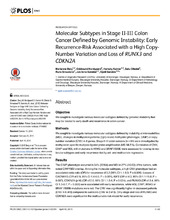| dc.contributor.author | Berg, Marianne | en_US |
| dc.contributor.author | Nordgård, Oddmund | en_US |
| dc.contributor.author | Kørner, Hartwig | en_US |
| dc.contributor.author | Oltedal, Satu | en_US |
| dc.contributor.author | Smaaland, Rune | en_US |
| dc.contributor.author | Søreide, Jon Arne | en_US |
| dc.contributor.author | Søreide, Kjetil | en_US |
| dc.date.accessioned | 2016-02-09T10:45:03Z | |
| dc.date.available | 2016-02-09T10:45:03Z | |
| dc.date.issued | 2015-04-16 | |
| dc.Published | PLoS ONE 2015, 10(4):e0122391 | eng |
| dc.identifier.issn | 1932-6203 | |
| dc.identifier.uri | https://hdl.handle.net/1956/11056 | |
| dc.description.abstract | Objective: We sought to investigate various molecular subtypes defined by genomic instability that may be related to early death and recurrence in colon cancer. Methods: We sought to investigate various molecular subtypes defined by instability at microsatellites (MSI), changes in methylation patterns (CpG island methylator phenotype, CIMP) or copy number variation (CNV) in 8 genes. Stage II-III colon cancers (n = 64) were investigated by methylation-specific multiplex ligated probe amplification (MS-MLPA). Correlation of CNV, CIMP and MSI, with mutations in KRAS and BRAFV600E were assessed for overlap in molecular subtypes and early recurrence risk by uni- and multivariate regression. Results: The CIMP phenotype occurred in 34% (22/64) and MSI in 27% (16/60) of the tumors, with noted CIMP/MSI overlap. Among the molecular subtypes, a high CNV phenotype had an associated odds ratio (OR) for recurrence of 3.2 (95% CI 1.1-9.3; P = 0.026). Losses of CACNA1G (OR of 2.9, 95% CI 1.4-6.0; P = 0.001), IGF2 (OR of 4.3, 95% CI 1.1-15.8; P = 0.007), CDKN2A (p16) (OR of 2.0, 95% CI 1.1-3.6; P = 0.024), and RUNX3 (OR of 3.4, 95% CI 1.3-8.7; P = 0.002) were associated with early recurrence, while MSI, CIMP, KRAS or BRAF V600E mutations were not. The CNV was significantly higher in deceased patients (CNV in 6 of 8) compared to survivors (CNV in 3 of 8). Only stage and loss of RUNX3 and CDKN2A were significant in the multivariable risk-model for early recurrence. Conclusions: A high copy number variation phenotype is a strong predictor of early recurrence and death, and may indicate a dose-dependent relationship between genetic instability and outcome. Loss of tumor suppressors RUNX3 and CDKN2A were related to recurrence-risk and warrants further investigation. | en_US |
| dc.language.iso | eng | eng |
| dc.publisher | PLOS | eng |
| dc.rights | Attribution CC BY | eng |
| dc.rights.uri | http://creativecommons.org/licenses/by/4.0 | eng |
| dc.title | Molecular subtypes in stage II-III colon cancer defined by genomic instability: Early recurrence-risk associated with a high copy-number variation and loss of RUNX3 and CDKN2A | en_US |
| dc.type | Peer reviewed | |
| dc.type | Journal article | |
| dc.date.updated | 2015-12-21T20:10:48Z | |
| dc.description.version | publishedVersion | en_US |
| dc.rights.holder | Copyright 2015 The Authors | |
| dc.identifier.doi | https://doi.org/10.1371/journal.pone.0122391 | |
| dc.identifier.cristin | 1253696 | |
| dc.subject.nsi | VDP::Medisinske fag: 700::Basale medisinske, odontologiske og veterinærmedisinske fag: 710::Medisinsk genetikk: 714 | |
| dc.subject.nsi | VDP::Midical sciences: 700::Basic medical, dental and veterinary sciences: 710::Medical genetics: 714 | |

